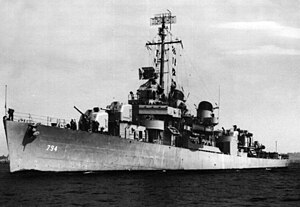USS Irwin

| |
| History | |
|---|---|
| Namesake | Noble E. Irwin |
| Builder | San Pedro, California |
| Laid down | 2 May 1943 |
| Launched | 31 October 1943 |
| Commissioned | 14 February 1944 |
| Decommissioned | 10 January 1958 |
| Stricken | 15 March 1973 |
| Fate |
|
| History | |
| Name | Santa Catarina (D32) |
| Acquired | 10 May 1968 |
| Stricken | 28 December 1988 |
| Fate | Sunk in 1990 |
| General characteristics | |
| Class and type | Fletcher-class destroyer |
| Displacement | 2,050 tons |
| Length | 376.5 ft (114.8 m) |
| Beam | 39.7 ft (12.1 m) |
| Draft | 17.9 ft (5.4 m) |
| Propulsion |
|
| Speed | 35 knots (65 km/h; 40 mph) |
| Range |
|
| Complement | 320 |
| Armament |
|
USS Irwin (DD-794), a
Irwin was
World War II
Following shakedown, Irwin departed
Irwin bombarded the enemy on
The Japanese fleet made a three-pronged approach to the Philippines 24 October 1944 for the Battle of Leyte Gulf. Planes from Irwin's carrier task group made destructive bombing runs on the Japanese Center Force of battleships and cruisers. But land-based Japanese bombers retaliated with heavy air strikes, scoring a lucky bomb hit on light carrier Princeton (CVL-23). In a heroic saga that brought Irwin the award of the Navy Unit Commendation, she braved raging flames, violent explosions, falling debris, and exploding shells as she went alongside Princeton. Fighting dense black smoke in a choppy sea, she rigged hoses and fought fires in the forward part of the hangar deck. Later, when an explosion blew off the major portion of the carrier's stern, Irwin immediately dispatched boats and some of her men dove into choppy seas to rescue survivors. Two of the divers were Charles Edward Kahler and Bert Townsend Jr. who were designated strong swimmers aboard the Irwin. Though damaged herself, the destroyer stood at close quarters until she had rescued 646 men from the sea and from the decks of Princeton.
Irwin headed for
Irwin helped screen attack carriers giving direct air support to the
Irwin remained off Okinawa until hostilities ceased with Japan 15 August 1945. She entered
1951 – 1958
Irwin recommissioned 26 February 1951 at
Steaming through the
Irwin engaged in coastwise operations out of Newport until 5 January 1955 when she sailed for NATO maneuvers in the North Atlantic, thence into the Mediterranean. She returned to Newport 26 May 1955, engaging in Atlantic seaboard operations until departure 29 March 1956 to base at Long Beach, California
Irwin arrived in Long Beach 15 April but soon deployed to spend the summer with the roving 7th Fleet in waters ranging from Japan to Okinawa, the Philippines and Taiwan. She returned to Long Beach 11 August for tactics ranging as far west as Hawaii, again sailing 12 March 1957 to join the 7th Fleet in the Far East. Following patrol of the
Irwin received the
Brazilian service
Irwin was transferred to Brazil 10 May 1968, where she was renamed Santa Catarina (D32).
Santa Catarina was stricken in 1988 and used thereafter as a practice target. In 1989 ex-D32 was used as target for the first launch of a live Sea Skua missile from a Brazilian Navy Westland Lynx helicopter. Ex-D32 was finally sunk in 1990.[citation needed]
References
- This article incorporates text from the public domain Dictionary of American Naval Fighting Ships. The entry can be found here.
- This article includes information collected from the Naval Vessel Register, which, as a U.S. government publication, is in the public domain. The entry can be found here.
